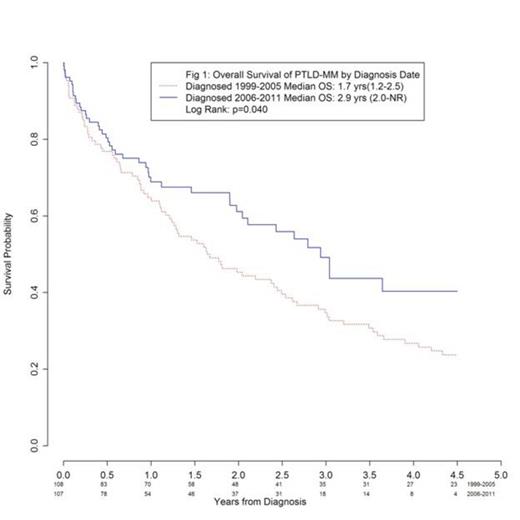Abstract
Although PTLD is a well described complication of solid organ transplantation (SOT), relatively little is known about multiple myeloma and plasmacytoma-like PTLD (PTLD-MM). We examined a large cohort of PTLD-MM patients (pts) in the Scientific Registry of Transplant Recipients (SRTR) investigating overall survival (OS) and the associated predictors of outcome.
The SRTR is a pt-level prospective database of all SOT recipients in the United States. Pts diagnosed with PTLD-MM in 1999-2011 were identified in text and standardized diagnosis fields. Baseline pt characteristics were obtained at the time of SOT and diagnosis. OS estimates were calculated using the Kaplan-Meier method, with follow up times censored at 4.5 years. Effects of baseline characteristics on survival were estimated in univariate analysis using Cox proportional hazards models; those with a p-value ≤ 0.10 were included in a multivariable model. January 1, 2006 was used to divide the data into two equal cohorts to ascertain the effect of diagnosis date on survival.
We identified 217 pts with PTLD-MM. Disease characteristics are outlined in Table 1. Median time from SOT to PTLD-MM diagnosis was 4.8 years (range 0-21); 18% of pts were diagnosed within 1 year of SOT, while 23% were diagnosed 10 years or more from SOT. In the cohort diagnosed 1999-2005, median time to PTLD-MM was significantly shorter than in the cohort diagnosed 2006-2011 (3.8 vs 5.2 years respectively, p = 0.048). Of those with complete data on performance status (PS), pts in the earlier cohort were more likely to have PS of 80-100 when compared to the later cohort (68% vs 52%, p=0.04). Therapy was detailed in 181 pts: 118 had immunosuppression reduced; 26 received corticosteroids; 62 received cytotoxic therapy; 3 received immunomodulatory agents; 44 received one of the novel agents thalidomide, lenalidomide or bortezomib; 56 underwent radiation therapy and 24 underwent debulking surgery. Median OS for the entire cohort, excluding 2 pts with unknown survival time, was 2.2 years (95% CI 1.7 - 3.0). Male gender, increased age, worse PS, hepatitis C infection at time of SOT, and diagnosis in the earlier cohort were all associated with worse OS in univariate analysis (Table 1). Therapy was not associated with OS in this study. Median OS was longer in those pts diagnosed 2006 – 2011 compared with those diagnosed 1999-2005 (2.9 vs 1.7 years, p=0.04 Figure 1). In multivariable analysis increased age (adjusted HR (aHR) 1.2 per decade, 95% CI 1.1 - 1.5, p=0.009), PS < 80 (aHR 2.1, 95% CI 1.4 - 3.2, p<0.001) and diagnosis 1999-2005 compared with 2006-2011 (aHR 1.8, 95% CI 1.2 - 2.7, p=0.006) remained significantly associated with decreased OS. Excluding date of diagnosis from the multivariable model did not change effect estimates of other baseline characteristics.
Baseline Characteristics and Univariate Analysis
| . | Number (% of cohort) . | Hazard Ratio (95% CI) . | P value . |
|---|---|---|---|
| Male* | 154 (71%) | 1.6 (1.04-2.43) | 0.03 |
| Increasing Age by 10 years* | 60 (3-80) | 1.3 (1.09-1.48) | 0.002 |
| Kidney vs Otder SOT | 118 (54%) | 1.0 (0.71-1.43) | 0.97 |
| HCV infected at time of SOT* | 19 (9%) | 1.8 (1.01-3.16) | 0.05 |
| HBV infected at time of SOT | 9 (4%) | 0.74 (0.30-1.82) | 0.51 |
| Prior Malignancy | 15 (7%) | 1.5 (0.78-2.92) | 0.22 |
| Years to PTLD | 4.7 (0-21) | 0.99 (0.96-1.0) | 0.74 |
| KPS <80* | 56 (26%) | 2.3 (1.50-3.47) | < 0.001 |
| Diagnosed 1999-2005* | 108 (50%) | 1.5 (1.02-2.13) | 0.04 |
| . | Number (% of cohort) . | Hazard Ratio (95% CI) . | P value . |
|---|---|---|---|
| Male* | 154 (71%) | 1.6 (1.04-2.43) | 0.03 |
| Increasing Age by 10 years* | 60 (3-80) | 1.3 (1.09-1.48) | 0.002 |
| Kidney vs Otder SOT | 118 (54%) | 1.0 (0.71-1.43) | 0.97 |
| HCV infected at time of SOT* | 19 (9%) | 1.8 (1.01-3.16) | 0.05 |
| HBV infected at time of SOT | 9 (4%) | 0.74 (0.30-1.82) | 0.51 |
| Prior Malignancy | 15 (7%) | 1.5 (0.78-2.92) | 0.22 |
| Years to PTLD | 4.7 (0-21) | 0.99 (0.96-1.0) | 0.74 |
| KPS <80* | 56 (26%) | 2.3 (1.50-3.47) | < 0.001 |
| Diagnosed 1999-2005* | 108 (50%) | 1.5 (1.02-2.13) | 0.04 |
Times reported as median (range)
Otder SOT: Heart 47 (22%), Liver 37 (17%), Lung 4 (2%), Intestine 1, Pancreas 1, Multiple 9 (4%)
Variables included in the multivariable model
To the best of our knowledge, this is the largest series of PTLD-MM reported to date. In contrast to prior reports (Blood 2013; 121: 1377-83, Haematologica, 2011; 96: 1067-71), outcomes of PTLD-MM were modest, with a median OS of only 2.2 years. Notably, OS has improved over time; those diagnosed in the latter half of our cohort had a 43% decrease in the risk of death compared to the earlier half. Trends in treatment and supportive care are likely to explain this improvement. Several prognostic factors identified pts with markedly divergent outcomes. Time from SOT to PTLD-MM was not associated with OS. Age and PS at diagnosis strongly predicted OS; risk of death increased by 20% for each decade of increased age, and doubled in pts with poor PS compared to those with preserved PS. Further examination of PTLD-MM is warranted to better understand these effects.
No relevant conflicts of interest to declare.
Author notes
Asterisk with author names denotes non-ASH members.


This feature is available to Subscribers Only
Sign In or Create an Account Close Modal